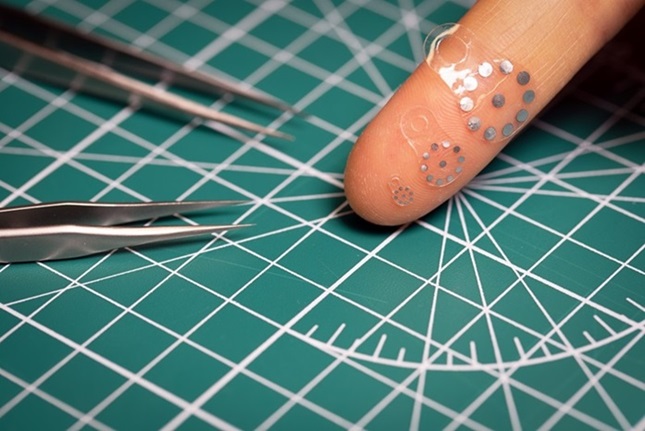Shape-Shifting Ultrasound Stickers Detect Post-Surgical Complications
Posted on 08 Mar 2024
Anastomotic leaks are a serious post-operative complication that can occur following gastrointestinal surgeries. These leaks are caused by gastrointestinal fluids escaping through subtle perforations or gaps in the surgical incision, posing significant health risks. Despite the prevalence of such leaks in all gastrointestinal surgeries, current diagnostic methods fall short in reliably and non-invasively detecting them. Neither ultrasound imaging tools nor advanced CT and MRI scans can directly identify these types of defects. Now, a first-of-its-kind sticker could enable clinicians to monitor these abnormal, life-threatening fluid leaks with a simple ultrasound device.
Developed collaboratively by researchers from Northwestern University (Evanston, IL, USA) and Washington University School of Medicine in St. Louis (St. Louis, MO, USA), the new soft and tiny sticker changes in shape when attached to an organ in response to the body’s changing pH levels. These shape changes, triggered by fluid leakage, can be monitored in real-time through ultrasound imaging. This groundbreaking approach allows for the early detection of post-surgery complications including anastomotic leaks, enabling timely interventions. Remarkably, once the patient fully recovers, the sticker, made of biocompatible and bioresorbable materials, dissolves naturally, eliminating the need for surgical removal.

The small, tissue-adhesive sticker is created using a flexible, chemically responsive, soft hydrogel material embedded with tiny, paper-thin metal disks. When exposed to leaking fluids, the hydrogel swells, causing the embedded metal discs to move apart. This subtle movement can then be visualized using ultrasound. To cater to different post-surgical needs, the stickers come in various sizes, ranging from a diameter of 12 millimeters to as small as 4 millimeters. Additionally, to overcome the potential challenge in manually interpreting these ultrasound images, the researchers have also developed specialized software that can automatically analyze the images for accurate detection of the relative movement of the discs.
The sticker's effectiveness was confirmed in rigorous testing with both small and large animal models. Ultrasound imaging consistently identified shape changes in the sticker, even when positioned 10 centimeters deep within tissues. The sticker responded to abnormal pH levels of leaked fluids within minutes, altering its shape accordingly. Ideal for use as an implant at the end of a surgical procedure, its small, flexible design also allows for it to be inserted into the body via a syringe. Due to their compact, thin, and soft nature, surgeons can place multiple stickers at different sites as needed. Moving forward, the research team is investigating the development of similar tags for detecting internal bleeding or temperature changes, thus expanding the scope of this innovative technology.
“Detecting changes in pH is a good starting point,” said Northwestern’s John A. Rogers, who led device development. “But this platform can extend to other types of applications by use of hydrogels that respond to other changes in local chemistry, or to temperature or other properties of clinical relevance.”
Related Links:
Northwestern University
Washington University School of Medicine in St. Louis










 Guided Devices.jpg)



